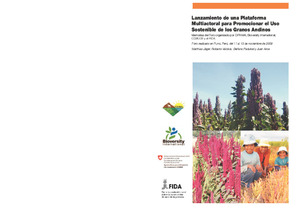Lanzamiento de una plataforma multiactoral para promocionar el uso sostenible de los granos andinos: Memorias del foro realizado en Puno, Perú, 11-13 de noviembre de 2009
Proceedings of a national workshop to launch a multi-stakeholder collaborative platform for the promotion of the sustainable conservation and use of Andean grains in Peru, held in Puno, Peru, in November 2009, in the framework of an international UN Programme supported by IFAD (‘IFAD NUS II Project’). The publication provides a very useful analysis of challenges and opportunities across the value chain of Andean Grains in Peru, along with recommendations to stakeholder groups on urgent actions needed to address the conservation and sustainable use of quinoa, cañihua and amaranth in the country in a more effective way. A collaborative platform links producer associations, research institutes, researchers, development agencies, civil society, the business sector and policy makers, promoting linkages, building synergies and cooperation along the value chain and can advocate for political support for promoting greater use of Andean grains. This approach shifts from the ‘traditional’ top-down approach, linking research to farmers through extension services, to a new paradigm, involving rural and agricultural innovation systems which link public and private sectors with farmers, civil society organizations and the scientific community. Thus the concept of “innovation” encompasses not only the “technological innovation” itself, i.e., the diffusion of new products and services of a technological nature into the economy, but it includes equally non-technological forms of innovation, such as institutional and organizational innovations.By bringing together all the different stakeholders into a single platform, interactions between producers, local authorities, NGOs, extension agents, service providers, researchers and buyers are facilitated. In this context, each stakeholder brings his/her particular expertise to the table to support the overall implementation of the value chain vision. Ultimately, this collective action is meant to improve the prospects of small farmers in agricultural markets.This document highly recommended for agencies and workers engaged in promoting Andean Grains in Peru and other countries in Latin America, where these crops are being increasingly recognized as strategic livelihood assets to fight poverty and nutrition insecurity within a climate changing scenario (in Spanish). Particularly useful is the description of the collaborative stakeholder platform and the approach used to put it in place.

